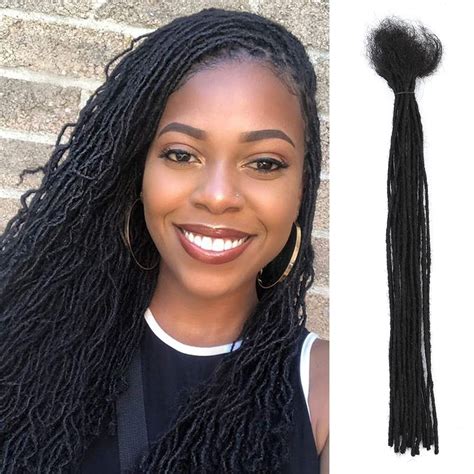Human hair extensions are a highly sought-after solution for those seeking to enhance their natural hair’s length, volume, or style. With the global hair extensions market projected to reach $13.4 billion by 2028, according to Grand View Research, it’s evident that these transformative solutions continue to captivate consumers worldwide.

Understanding Human Hair Extensions
Human hair extensions are crafted from real human hair, harvested ethically from donors worldwide. This allows for unmatched naturalness in terms of texture, color, and movement. Unlike synthetic extensions, which can appear artificial and stiff, human hair extensions blend seamlessly with your existing hair.
Types of Human Hair Extensions
The market offers a wide array of human hair extension types, catering to diverse needs and preferences:
- Clip-ins: Temporary extensions that attach to your hair using clips. Ideal for quick and easy transformations.
- Tape-ins: Long-lasting extensions that adhere to your natural hair using adhesive tape. Provide a more secure hold than clip-ins.
- Sew-ins: Permanent extensions that are sewn into your natural hair. Offer maximum longevity and customization options.
- Fusion: Extensions that are attached to your hair using heat-resistant glue. Provide a seamless and natural appearance.
- Microbeads: Tiny extensions that are clamped onto your natural hair using beads. Offer a gentle and damage-free attachment.
Benefits of Human Hair Extensions
Choosing human hair extensions over synthetic alternatives offers numerous benefits:
- Natural Appearance: Blend seamlessly with your own hair for a realistic and cohesive look.
- Customization: Available in a wide range of lengths, colors, and textures to match your desired style.
- Versatility: Can be styled, washed, and colored just like your own hair, providing endless styling possibilities.
- Long-Lasting: With proper care, human hair extensions can last for several months, making them a cost-effective investment.
- Confidence Boost: Transform your appearance instantly, boosting your confidence and self-esteem.
Common Mistakes to Avoid
To ensure the longevity and satisfaction of your human hair extensions, avoid these common pitfalls:
- Overheating: Avoid using high temperatures on your extensions, as this can damage the hair.
- Overwashing: Wash your extensions every 7-10 days to prevent oil buildup.
- Using Harsh Chemicals: Use sulfate-free shampoos and conditioners to protect the hair from damage.
- Brushing Improperly: Brush your extensions gently starting from the ends to avoid tangling.
- Sleeping with Wet Extensions: Allow your extensions to dry completely before going to bed to prevent breakage.
Why Human Hair Extensions Matter
Human hair extensions are more than just a cosmetic enhancement. They empower individuals to express their unique style, boost their confidence, and fulfill their hair aspirations. They offer a transformative solution that can:
- Conceal Hair Loss: Extend hair length and volume to cover thinning areas or bald spots.
- Enhance Appearance: Create the illusion of thicker, fuller, and more lustrous hair.
- Complement Hairstyles: Add length and volume to existing hairstyles, enabling the creation of intricate braids, ponytails, and updos.
- Experiment with Color: Experiment with bold colors or highlights without risking damage to your natural hair.
- Protect Hair from Damage: Extensions can act as a protective layer, shielding your natural hair from heat styling and environmental stressors.
- Hypoallergenic: Human hair extensions are hypoallergenic, making them gentle on sensitive skin and suitable for all hair types.
Transforming the Industry: “Applicatography”
Beyond their traditional applications, human hair extensions are inspiring innovative uses in the beauty and fashion industries. “Applicatography” encapsulates this emerging field of experimentation, where extensions are repurposed to create never-before-seen hair artistry.
- Hair Sculpting: Create intricate hair sculptures and accessories that defy gravity and make a bold statement.
- Fashion Accessories: Integrate extensions into clothing, jewelry, and accessories for a unique and eye-catching touch.
- Cosplay and Entertainment: Enhance costumes and characters with vibrant and realistic hair extensions.
- Educational Tools: Use extensions in hairdressing schools and workshops to demonstrate techniques and showcase different hair types.
- Sensory Therapy: Provide tactile stimulation and comfort for individuals with sensory sensitivities.
Conclusion
Human hair extensions offer a versatile and transformative solution for individuals seeking to enhance their natural hair’s length, volume, and style. With a range of types and benefits available, these extensions empower consumers to express their unique individuality and fulfill their hair aspirations. Embracing “applicatography” further unlocks innovative uses and applications, expanding the boundaries of hair artistry and expression.
Tables
Table 1: Human Hair Extension Types and Attachment Methods
| Type | Attachment Method |
|---|---|
| Clip-ins | Clips |
| Tape-ins | Adhesive tape |
| Sew-ins | Sewing |
| Fusion | Heat-resistant glue |
| Microbeads | Beads |
Table 2: Benefits of Human Hair Extensions
| Benefit | Impact |
|---|---|
| Natural Appearance | Seamlessly blend with natural hair |
| Customization | Match desired style |
| Versatility | Style, wash, and color like natural hair |
| Long-Lasting | Months of wear with proper care |
| Confidence Boost | Enhance self-esteem and confidence |
Table 3: Common Mistakes to Avoid When Using Human Hair Extensions
| Mistake | Consequence |
|---|---|
| Overheating | Damage to hair |
| Overwashing | Oil buildup |
| Using Harsh Chemicals | Hair damage |
| Brushing Improperly | Tangling |
| Sleeping with Wet Extensions | Breakage |
Table 4: Innovative Applications of Human Hair Extensions (“Applicatography”)
| Application | Purpose |
|---|---|
| Hair Sculpting | Intricate hair art |
| Fashion Accessories | Unique hair accessories and adornments |
| Cosplay and Entertainment | Enhance costumes and characters |
| Educational Tools | Demonstrate hairdressing techniques |
| Sensory Therapy | Tactile stimulation and comfort |
